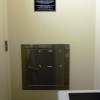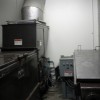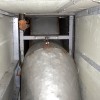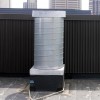Trash Chutes
Video
alt="" Trash ChutesTrash chutes evolved as a sanitary and economical means of collecting the refuse generated by building occupants in mid-rise and high-rise buildings. The word chute is derived from the French word meaning to fall or drop. Chutes are tubes through which objects slide from a higher to a lower level by means of gravity. There are linen chutes used by hospitals and hotels; construction trash chutes used to handle construction debris in multi-story construction sites; and trash chutes used in multi-story condominiums, apartments, and dormitories. In a trash chute application, the bottom of the chute below the discharge door is a steel container typically located in the trash room. The steel container can be a fully automatic, hydraulically operated compactor or a small, simple cubic yard steel container. Recent developments by many manufacturers have made possible a collection system that allows for the automatic separation and collection of recyclable materials.
Trash chutes must be continuous and remain uninterrupted from floor to floor through the entire building, from the lowest level through the roof. Like an elevator shaft, trash chutes can create a chimney effect for the spread of smoke and fire throughout the building if the chute is not protected by a fire rated assembly. Building codes will regulate the rated wall assembly required to protect the vertical shaft created by a trash chute. The National Fire Protection Association (NFPA) regulates the design, installation and maintenance of trash chutes. To help reduce the spread of fire and smoke through a trash chute, chutes must comply with NFPA 82: “Standard on Incinerators and Waste and Linen Handling Systems and Equipment”. NFPA recommends a minimum standard chute size of 24" diameter. It also covers requirements for the installation, maintenance, use of waste and recyclables, storage rooms, containers, handling systems, incinerators, compactors, and linen and laundry handling systems. The vertical shaft created by the trash chute is required to be protected by a 2-hour fire rated shaft wall assembly for its full height.
Trash Chute Components
- Compactor: single waste container or multiple containers for a recycling system, typically located in the trash room
- Discharge door
- Steel chute with expansion joints that are typically located at each floor
- Chute Support Frames: installed at each floor, usually made of steel angles and bar stock secured to the floor
- Trash chute intake door at each floor, typically hinged at the bottom
Chutes are generally constructed of heavy gauge (typically 16 gauge) metal such as aluminized steel, galvanized steel, or stainless steel. Most trash chute manufacturers offer chute diameters from 20" up to 36". The intake door and discharge door size is dependent on the size of the chute diameter specified. The table below details the recommended door sizes based on the chute diameter.
Recommended Door Sizes |
||
|
Chute Diameter |
Intake Door Size (W x H) |
Discharge Door Size (W x H) |
|
20 “ |
15” x 18” |
20” x 30” |
|
24” |
15” x 18” |
24” x 30” |
|
28” |
18” x 18” |
28” x 36” |
|
30” |
18” x 18” |
30” x 36” |
|
36” |
21” x 18 |
36” x 48” |
Intake doors are self closing and are typically constructed of stainless steel. Because these doors are required to carry a “B” label, 1 1/2 hour rated assembly, they will also have a positive latch with a hand operated door control and a metal frame suitable for enclosing the chase. These doors can have an electric interlock which allows only one door to be in use at any given time and keeps the other intake doors positively locked at all times except during use.
The discharge door is located at the bottom of the chute, just above the compactor or other collection container. Its primary purpose is to securely close off the bottom of the chute in the event of a fire. There are two main types of discharge doors: standard and hopper-type. Standard discharge doors consist of a sliding discharge plate in a steel track assembly that is spring loaded and held open with a fusible link. Hopper-type discharge doors consist of a steel "B" label constructed type door (1 1/2 hour rating for a 2 hour wall assembly) held open by a fusible link, and are used when a 90° offset is required to go through a wall.
Both types of discharge doors are held open with a U.L. approved fusible link. The fusible link is designed to fail when the ambient temperature reaches a pre-determined temperature (typically 155 to 165 degrees). When the link fails or is broken, the door will be released to close and seal off the bottom of the chute to provide the necessary fire rating. Other fire safety precautions include an automatic sprinkler head above the highest intake, with additional sprinkler heads at every second intake (starting from the top). Local codes will stipulate the required extent and location of sprinkler heads. Also, trash chute vents are required to extend 4'-0" above the roof deck, per NFPA recommendations, with a metal explosion cap.
Other accessories to help maintain, clean and deodorize trash chutes include a flushing spay unit located above the highest intake door which is connected to the building water supply. Also located above the highest intake door is the option for a sanitizing and disinfecting unit. This is also connected to the building’s water supply, where it mixes water with the sanitizing and disinfecting solution and is intended to wash down the sides of the metal chute. To help control potential noise, a sound dampening material can be applied to the outside of the metal chute.

Buildipedia Staff
The Buildipedia research and writing staff consists of dozens of experienced professionals from many sectors of the industry, including architects, designers, contractors, and engineers.
Website: buildipedia.com/




